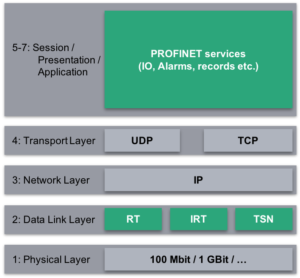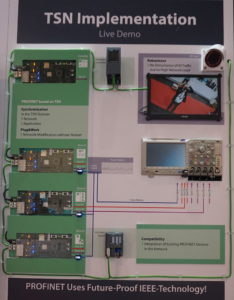“TSN really works!”
That was the statement of one of the many visitors to the PI booth following the TSN live demonstration at Hannover Fair 2018. Of course, this was no surprise to us! After all, we’ve been closely working for some time now with TSN technology itself and the possible integration of PROFINET.
 In addition to this statement, there was a broad spectrum of discussions concerning TSN mechanisms at the demo – ranging from “I seem to recall hearing something about it once” to the specific queue handling of TSN.
In addition to this statement, there was a broad spectrum of discussions concerning TSN mechanisms at the demo – ranging from “I seem to recall hearing something about it once” to the specific queue handling of TSN.
What everyone clearly seemed to agree on was the presentation and strategy of retaining the tried-and-tested PROFINET communication mechanisms – unchanged – with their familiar interfaces to the application and, thus, to the user. TSN is “simply” an additional Layer-2 that we use consistently.
Content of the Demo
Synchronization of the Network and Application
 During the TSN demo, we established communication between a PN controller and three PN devices, based on the hardware of an available TSN Ethernet development board and an available PROFINET stack. In a simple automation task, input patterns were copied back to the outputs. Both the synchronization of the participants’ working clock and the synchronization of the outputs were clearly visible on an oscilloscope.
During the TSN demo, we established communication between a PN controller and three PN devices, based on the hardware of an available TSN Ethernet development board and an available PROFINET stack. In a simple automation task, input patterns were copied back to the outputs. Both the synchronization of the participants’ working clock and the synchronization of the outputs were clearly visible on an oscilloscope.
Plug & Work
TSN allows for a change in the wiring without reengineering. One device was removed and bypassed. The network was able to reconfigure itself based on the new arrangement.
Compatibility
Existing PN devices can be connected – unchanged – to a TSN domain.
Robustness
The high network load generated by a webcam does not interfere with the IO communication.
Specific Implementation
The demo showed that the specific implementation of TSN in PROFINET works and can offer the expected features. Developmental work in the depths of the specification has already begun. Now we have to – and intend to – present our users and device manufacturers not only with the strategy and principles of TSN integration but with additional detailed information.
With this knowledge, they will be better equipped to assess any skewed presentation they encounter and to pursue their own planning.
After the fundamental strategic definition in this step, we proved that we are able to integrate a future-proof technology. The next steps will steadily follow, enabling us to precisely shape today’s communication technology – and that of the future.
Xaver Schmidt 
Industrie 4.0 Working Group
